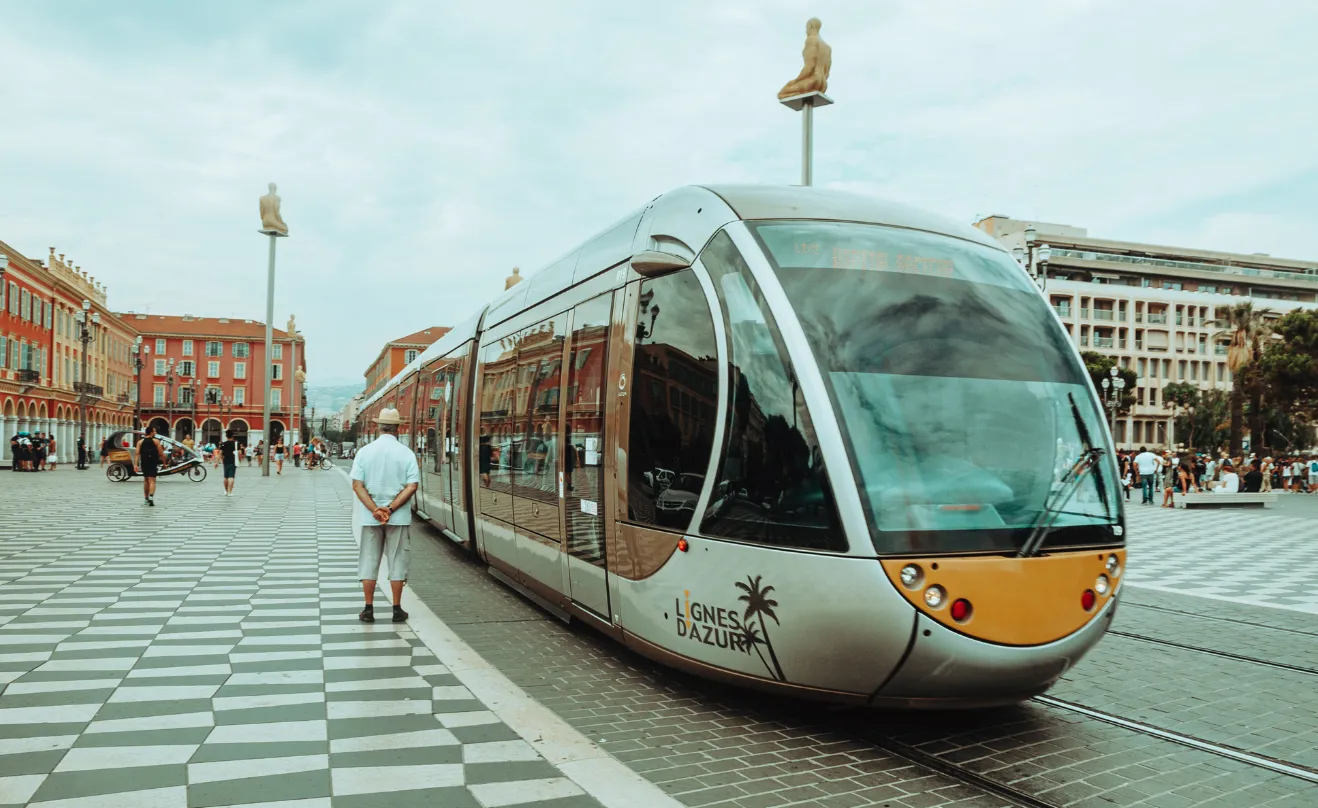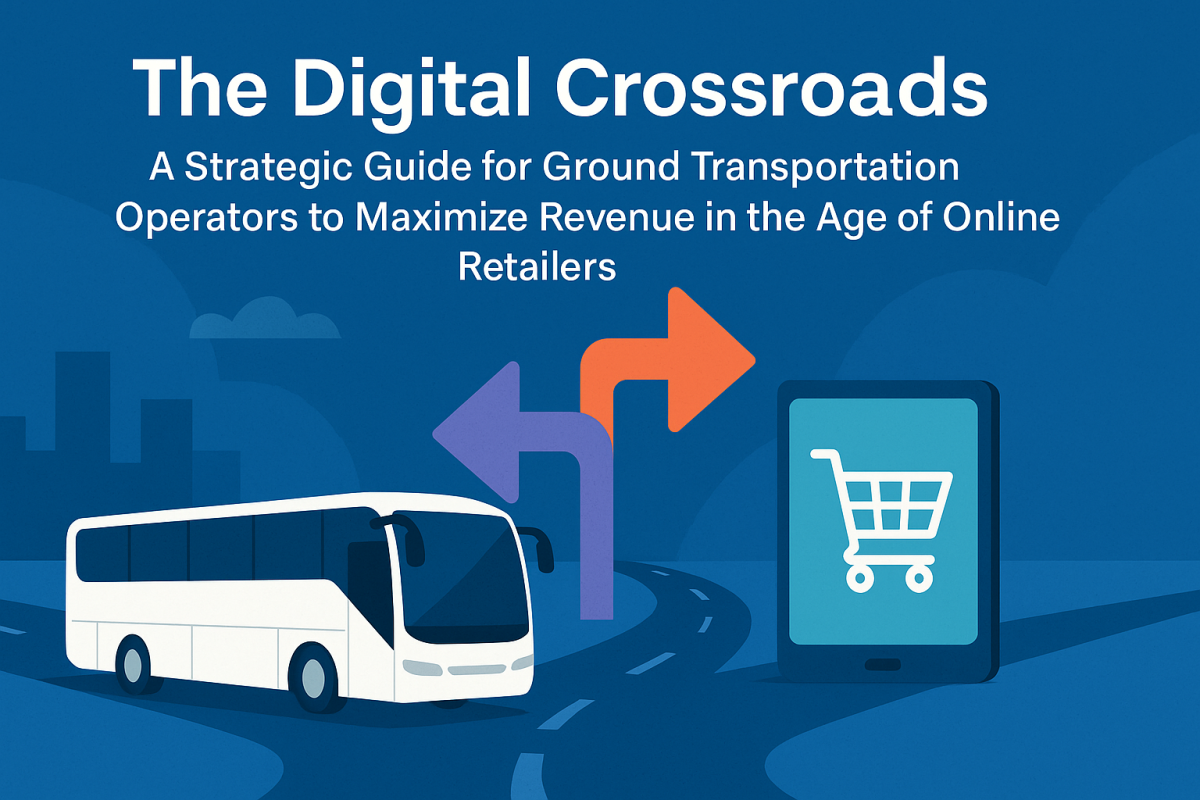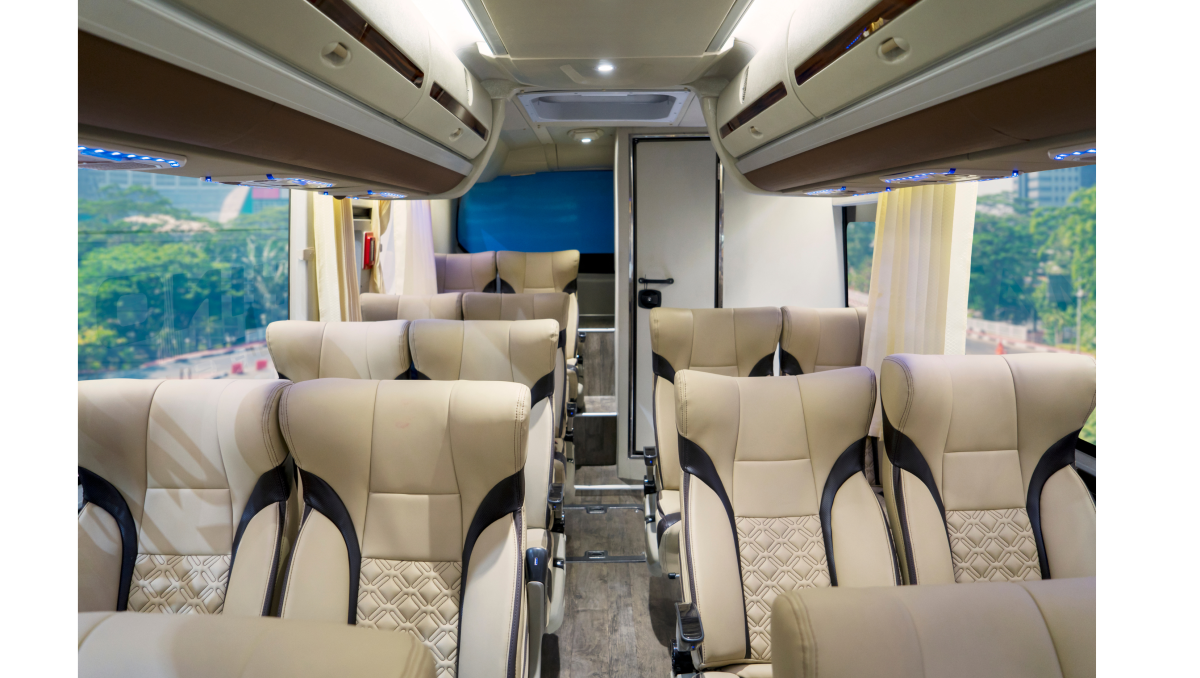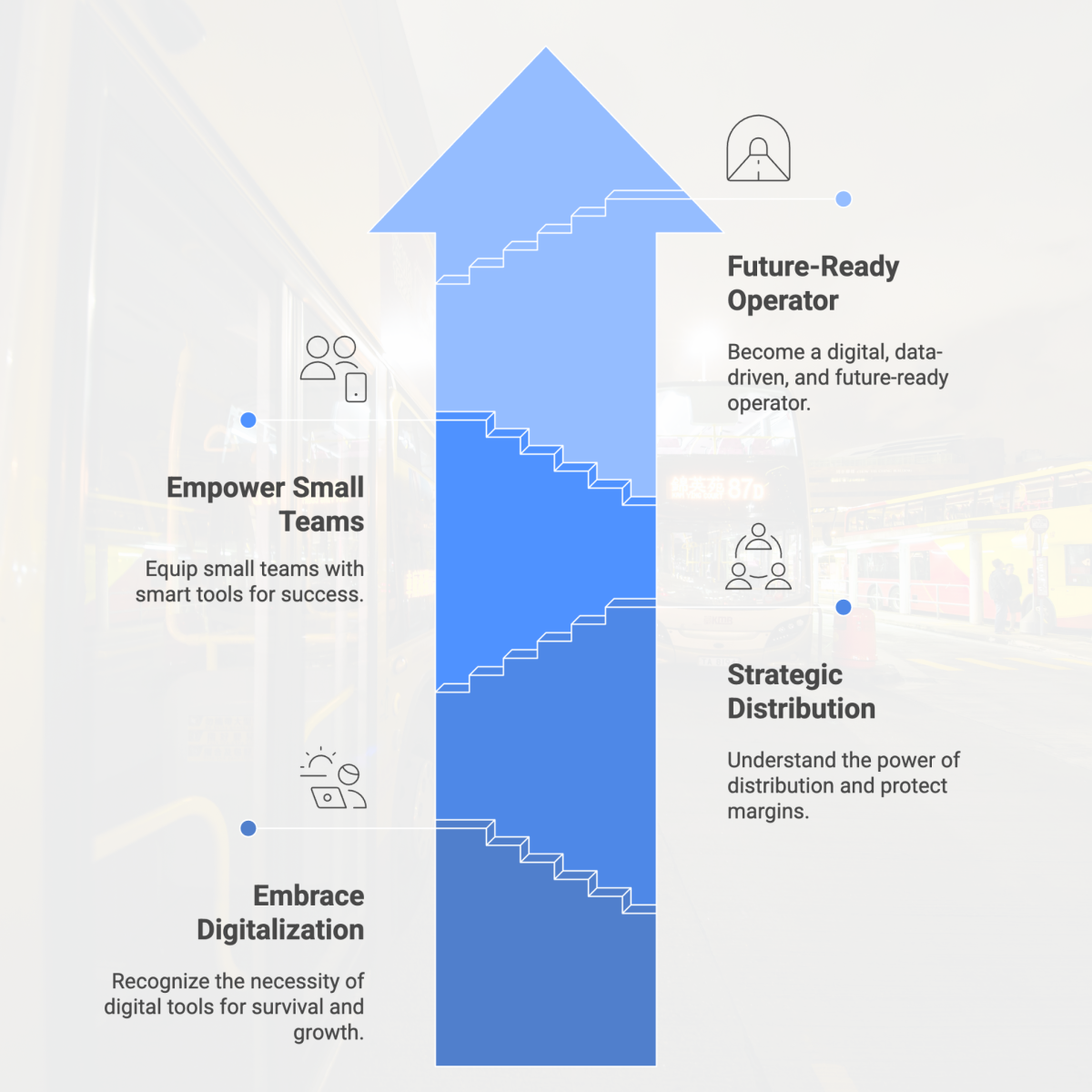The Digital Crossroads: A Strategic Guide for Ground Transportation Operators to Maximize Revenue in the Age of Online Retailers

The Digital Crossroads: A Strategic Guide for Ground Transportation Operators to Maximize Revenue in the Age of Online Retailers.

Let's be real. When ground transportation operators think about online retailers, the conversation quickly turns to resellers, and then to one word: commission. As Samim Rostainajad, Head of Sales at Zaui, put it in a recent webinar, "We really understand what you think... you think, 'Wait, I don't have the margins to be playing 15 to 30% in commission,' which is 100% understandable."
This guide is about ripping off that band-aid. It’s packed with actionable strategies from industry experts that you can use to leverage Online Travel Agencies (OTAs) in a smart, strategic way to grow your business, regardless of the margins.
The Unstoppable Shift: Navigating the New Ground Transportation Landscape
If you're in the ground transportation business, you know that things are changing fast. The industry is at a major turning point, and standing still isn't an option anymore. A perfect storm of market consolidation, a growing "digital divide," and new passenger expectations means it's time to adapt. Let's break down the big trends that are pushing the industry forward and see why embracing digital isn't just a good idea, but a necessity for growth.

The Ground is Moving: A Market in Consolidation
The ground transportation market is in a period of rapid and accelerating consolidation. Big, tech-savvy players are growing faster than ever, putting a lot of pressure on smaller, independent operators. This isn't just happening in one place; it's a global trend. Major carriers like FlixBus and its subsidiaries are expanding their networks across key markets like France, Germany, North America, Brazil, and Turkey.
This isn't just about buying more buses. It's about using technology to get ahead. As Zaui's CEO, Kasper Fjetland, explains, these companies have changed the rules because "they don't own the buses, they own the demand." They use sophisticated digital platforms to run more efficiently, set smarter prices, and reach customers all over the world in ways that old-school, manual methods just can't match. They use data to perfect their routes, manage their fleets, and use dynamic pricing to get the most revenue out of every seat. This tech advantage creates a huge competitive gap, leaving non-digital operators struggling to keep up. In this new market, scale powered by technology is king, and the pressure is on for everyone else to adapt.
The Digital Divide: A Widening Chasm Between Stagnation and Growth

A huge gap has opened up in the industry, separating operators who have gone digital from those still stuck in the analog world. "If you're still using spreadsheets, sticky notes, or booking over the phone, you're already falling behind," warns Kasper, CEO, Zaui. This isn't just about having a website; it's about market access, efficiency, and long-term survival. The numbers tell a clear story. A massive 87.5% of all ground transportation sales still happen offline, with only 12.5% happening online. Even with more generous estimates putting online bookings at 24%, the vast majority of business is still done the old-fashioned way.
This is a problem because the real growth is happening online. The online bus ticketing market is set to explode, projected to jump from a compound annual growth rate (CAGR) of 22.71%! At the same time, the wider ground transport market is also growing, but at a more modest 9.6% CAGR.
What does this mean for you? If you're not digitized, you're invisible to the fastest-growing part of the market. You're fighting for a piece of the offline pie, which is getting smaller every year. Your manual processes for booking and scheduling are slower, more expensive, and more likely to have errors than the automated systems your competitors are using. Worse, you're locked out of the smart revenue strategies that are now standard. Without the right tech, you can't use dynamic pricing, manage sales across different channels, or analyze customer data to improve your service. This makes you vulnerable and a prime target for the big consolidators like FlixBus. In short, failing to go digital isn't just about missing out on sales; it's about risking the future of your business.
The Modern Passenger: Meeting the Demands of the Digital-First Traveler
The most important driver of change is, of course, the passenger. Today's travelers are used to the seamless digital experiences they get from companies like Amazon and their bank, and they expect the same from transportation. This is especially true for younger Gen Z and Millennial travelers, who have grown up with technology.
These digital natives want convenience, real-time information, and the ability to manage their travel on their phones. In fact, almost two-thirds of travelers have used a mobile device for their recent trip reservations, and 38% have used a travel app. A mobile-friendly booking experience isn't a luxury anymore; it's a basic requirement. One survey found that while 39% of UK travellers already use ride-hailing apps, a huge 69% believe the use of mobility apps will only increase.
It's not just about booking, either. Passengers expect live updates on their trip, automated messages, and personalized service. A whopping 72% of consumers now expect companies to understand their unique needs. If your business still relies on phone calls and paper tickets, you're not speaking your customers' language. This friction leads to a bad experience and lost business, as passengers flock to competitors who offer the smooth, digital service they've come to expect.
The Distribution Ecosystem: A Comprehensive Guide to the World of Online Retailers
To connect with today's digital-first traveller, you need to tap into the wide world of online retailers. These platforms are the new town squares where people discover, compare, and buy travel. Understanding this ecosystem isn't just about tech, it's about strategically putting your seats "where demand is." Let's demystify the world of online distribution and help you build a powerful and profitable sales strategy.
Understanding the Players: Who Sells Your Seats?

An online retailer is any digital platform that sells travel inventory like bus tickets, hotel rooms, or tours to customers, usually for a commission. For you, these retailers are more than just a sales channel; they're your ticket to new markets, new customers, and global visibility. The ecosystem is diverse, so a smart strategy means knowing who's who.
Here are the main types of online retailers:
- Online Travel Agencies (OTAs): Think of these as the department stores of travel. Platforms like Booking.com, Wanderu, and Busbud bring together tons of travel options in one place. OTAs like Wanderu partner with hundreds of carriers to offer competitive prices and a simple checkout, making them a go-to for leisure travellers and bargain hunters.
- Tours and Activities Platforms: Retailers like GetYourGuide, Klook, and Tiqets focus on the "in-destination" experience. They connect with travellers who are already planning their trip and looking to book attractions, day trips, and local activities. If you offer airport transfers or scenic routes, these platforms are a great way to reach them.
- Metasearch Engines: These are often the first stop for travellers. Sites like Google, Kayak, CheckMyBus, and Rome2Rio don't sell tickets themselves. Instead, they pull in data from hundreds of other sites, letting users compare all their options before sending them to an OTA or your website to book. Their power is in their massive reach.
- Travel Management Companies (TMCs): These platforms are for business travel. Companies like Navan (formerly TripActions), SAP Concur, and TravelPerk help businesses manage all their employee travel in one place. Partnering with TMCs gives you access to the valuable corporate travel market.
- Carrier/Retailers: Some transportation companies, like Megabus, Trailways, and Alsa, act as both operators and retailers, selling their own tickets directly through their own powerful websites. They're competitors, but they also show the value of a strong direct-to-consumer brand.
- Super-Apps: In many parts of the world, especially Asia and Latin America, Super-Apps like Alipay, WeChat, and Rappi are dominant. They combine everything from messaging and payments to travel booking into one app. If you want to reach travelers from these regions, being on these platforms is key.
The Economics of Partnership: Commissions, Costs, and Value
Working with these retailers means understanding the money side of things. The relationship between operators and OTAs is often called "frenemies." They give you incredible market access, but it comes at a price. Most work on a commission model, where you pay the OTA a percentage of every ticket they sell for you.
These commission rates typically range from 15% to as high as 30%. The exact rate depends on your size, your market, and your deal. Smaller, independent operators often pay higher rates, as OTAs save their best deals for their biggest partners.
A 25% commission on a $100 ticket might sound like you're losing $25. But a smarter way to look at it is as an investment in getting a new customer. That $25 is your Customer Acquisition Cost (CAC) for a passenger you probably wouldn't have reached on your own. The real question is whether the long-term value of that customer is worth the cost.
This is where Customer Lifetime Value (LTV) comes in. If you can turn a customer you got from an OTA into a direct booker for their next trip, that initial $25 commission becomes a very smart marketing spend. If that customer books directly with you two more times, the profit you make from them far outweighs the initial cost. This mindset is only possible if you have a digital system that can track where your customers come from and help you market to them directly.
Plus, there's another benefit: the "billboard effect." Just being listed on a major OTA makes your brand look more credible. Many travellers use OTAs to research and then go to the operator's website to book directly, hoping for a better deal. In that case, the OTA just acted as a free marketing tool that drove a high-profit sale directly to you.

So, with so many OTAs, how do you decide who to partner with first? It's a "chicken and egg" problem, but as Ryan Knapp from Distribusion advises, a good starting point is to focus on the OTAs most active in your region. Experts at a distribution network can provide guidance and even help negotiate better commission rates through the "powers of economy of scale," passing savings on to you.
Table: Choosing Your Retail Partners: A Strategic Overview
To build a smart distribution plan, use this framework to pick the right retail partners for your business goals.
The Technology Stack: Powering Your Connection to the Global Market
To successfully connect with online retailers and use smart revenue strategies, you need the right technology. For ground transportation operators, this means an integrated tech stack that can manage complex operations, connect you to global markets, and automate key tasks. Let's look at the essential tools that bridge the gap between your inventory and the world of online demand.
The Challenge of Fragmentation: Connecting Supply and Demand
The biggest tech challenge in ground transportation is that the industry is incredibly fragmented. There are over 2,000 different carriers, each with its own schedules, prices, and systems. On the other side, there are over 250 online retailers, all looking to sell those seats.
For one operator to manually manage connections with even a few of these retailers would be an operational nightmare. It would be slow, expensive, and full of errors. This is the problem that a modern tech stack solves: creating a seamless and scalable bridge between supply and demand.
The Engine Room: Your Reservation System
At the heart of your tech stack is your reservation system. A modern platform like Zaui is much more than a booking tool; it's the central nervous system of your entire operation. This is where all your core business information lives.
Its key functions are built specifically for transportation:
- Complex Operations Management: It can handle multi-stop routes, different schedules, various seat types, and passenger manifests with ease.
- Direct Channel Empowerment: It gives you a mobile-friendly, high-converting online booking engine for your own website. This is key for capturing profitable direct bookings.
- Scalability: It's designed to grow with you, whether you have one route or an international network.
A solid reservation system is the first step in any digital transformation.
The Global Superhighway: Your Distribution System
While the reservation system manages your inventory, the distribution system connects it to the world. For ground transportation, this is a Global Distribution System (GDS) built for the industry, like Distribusion. Ryan Knapp, Head of BD for North America at Distribusion, frames their goal simply: "making booking ground transportation as easy and as intuitive as booking a flight."
He illustrates the point with a personal story: booking a flight from his home in Germany to Niagara Falls, New York, is simple. But finding a bus from Niagara Falls to a nearby town? "Not so much." A GDS solves this by acting as a single point of connection a "global superhighway" that links your reservation system to the entire network of online retailers. Instead of building hundreds of individual connections (often using complex APIs, which are just standardized ways for systems to talk to each other), you just build one. The GDS handles all the complexity for you, including contracts, technical integrations, and payments. For example, Distribusion is the technology that powers Google's intercity search results and Google Maps' ticketing features, putting you right inside the world's most popular travel planning tool.
The Integrated Stack: How It All Works Together
The real power is in how these tools work together. Your reservation system (like Zaui) and your GDS (like Distribusion) create a fully automated, real-time distribution machine. Here's how it works:
- You manage your schedules, routes, and prices in your central reservation system.
- The reservation system sends this information in real-time to the GDS.
- The GDS instantly sends it out to its entire network of retailers.
The most important part is the real-time, two-way synchronization. When a booking is made on any channel; your website, an OTA, or a metasearch site, the GDS tells your reservation system, which updates your master inventory. That change is then immediately pushed out to all other channels. A seat sold on Wanderu is instantly gone from Booking.com. This automated flow eliminates the risk of overbooking, which saves you money, headaches, and protects your brand's reputation.
This integrated stack changes technology from a cost to a tool for growth. As Kasper Fjetland notes, "Tech levels the playing field. With smart systems in place, a team of five can operate with the speed and efficiency of a team of fifty." It gives you the features you need, like inventory throttling and dynamic pricing, to protect your margins on every ticket. It's not just about saving time; it's about unlocking new revenue. Case studies show that this kind of digital transformation can lead to direct revenue increases of 23-27% and a big shift toward more profitable direct bookings.
The Revenue Maximization Playbook: Four Core Strategies for Profitable Growth
Once you have the right technology, you can go on the offensive. The goal is no longer just to sell seats, but to sell the right seat to the right customer at the right time for the right price through the right channel. This requires a smart, data-driven approach. Here's a four-part playbook to help you drive profitable growth.
Strategy 1: The Art of Yield Management: Use OTAs to Fill Gaps, Not Cannibalize Core Business
The first strategy is to master yield management. This means treating OTAs as a tool to fill empty seats, not as your main sales channel. A common mistake is giving OTAs access to all your inventory all the time. This means you end up paying high commissions on seats you could have sold directly for full profit. As Kasper explains, the smartest operators use OTAs strategically: "You open the flood gates when you need bookings and you tighten access when demand is high."
Execution: The smart approach is to strategically "throttle" your inventory using the channel management features in your reservation system. This gives you control over which seats are available on which channels. The strategy is simple:
- For low-demand periods: Open the floodgates to OTAs. This is perfect for midweek trips, off-seasons, or last-minute unsold seats. An OTA booking with a 25% commission is much better than an empty seat.
- For high-demand periods: Limit or close OTA access. This applies to weekends, holidays, and popular routes where you're likely to sell out through your high-margin direct channels.
Impact: This targeted approach ensures OTAs bring you new revenue you wouldn't have had otherwise. It helps you maximize your fleet's use and overall revenue without giving away your best inventory or paying unnecessary commissions.
Strategy 2: Dynamic Pricing: Automate Your Margin Protection
Static pricing is where a ticket always costs the same is a thing of the past. A dynamic pricing strategy, powered by your reservation system, lets you automatically protect your margins and react to the market in real-time.
Execution: Using a tool like Zaui's dynamic pricing engine, you can set up automated "if-then" rules that adjust your fares. A great way to use this is to build in commission-buffers for different channels. For example, you can set a rule like:
- IF Channel = OTA_Partner_Y (25% commission), THEN Increase_Price = 1.20
- IF Capacity < 10%, THEN Increase_Price = 1.15
These rules automatically adjust the price on each channel, so your net revenue (what you get after commission) stays consistent and protected, no matter where the booking came from.
Impact: This strategy automates your margin protection, so you don't have to constantly adjust fares by hand. It makes your business more agile and ensures you're never leaving money on
Strategy 3: The Profitability Equation - Master CAC vs. LTV
A truly smart revenue strategy looks beyond a single ticket sale to the long-term value of each customer. This means understanding the relationship between Customer Acquisition Cost (CAC) and Customer Lifetime Value (LTV).
Execution: This is a three-step process that your reservation system makes possible:
- Calculate CAC: This is how much it costs to get a customer. For an OTA booking, it's the commission you paid. For a $40 ticket with a 15% commission, your CAC is $6.
- Calculate LTV: This is the total profit a customer brings you over time. If a typical customer rides 3 times a year, generating $4 in profit per ride, and stays with you for 3 years, their LTV is $4 \times 3 \times 3 = $36.
- Analyze the Ratio: Compare the two. In this case, the $LTV:CAC$ ratio is $36:\$6, or 6:1. A ratio of 3:1 is good; 6:1 is excellent. It proves that the initial $6 commission was a great investment.
Impact: This approach gives you a clear, data-backed way to see which channels are most profitable. It shifts your focus to a crucial goal: converting customers from high-CAC channels (like OTAs) into loyal, direct-booking customers. By using their data to send a follow-up offer, you can maximize the LTV of every passenger.
Strategy 4: Transparent Cost-Sharing: Pass On the Booking Fee
The final strategy is a simple and common practice in the travel industry: passing a small part of the distribution cost to the customer as a transparent booking fee.
Execution: Modern booking engines make this easy. During checkout, you can add a line item for a "Booking Fee" or "Service Fee." This is standard for airlines and concert venues. The key is to be transparent and clearly label the fee.
Impact: This directly protects your base margin on the ticket. It's a simple but effective way to offset OTA commissions and the costs of running your digital booking system without making your ticket prices seem higher.
Table: Revenue Strategy Implementation Checklist
This checklist summarizes the playbook, linking each strategy to the tech you need and the KPIs to track.
The Road Ahead: Future-Proofing Your Ground Transportation Business
By using the strategies and tech in this guide, you'll be set up for success today. But the world keeps changing. To stay ahead, you need to look to the future and get ready for the next wave of innovation. Let's explore the emerging trends of AI and integrated mobility to see how you can future-proof your business for tomorrow.
The Rise of the Intelligent Journey: AI and Hyper-Personalization
The next big thing in digital transformation is Artificial Intelligence (AI). While AI is already used for things like route optimization, its biggest impact will be on the customer experience. The future of travel isn't just digital; it's intelligent and hyper-personalized. As Kasper notes, in this industry, "AI will be a massive help, it won't be a destroyer."
Here's what's coming:
- AI-Powered Customer Service: AI chatbots and virtual assistants can offer 24/7 support, answering questions and helping with bookings without needing a human.
- Personalized Recommendations: AI can analyze a traveler's past trips to offer tailored suggestions and deals, making them happier and increasing your revenue per passenger.
- Predictive Operations: By analyzing data on past bookings, weather, and local events, AI can predict demand with amazing accuracy. This helps you optimize schedules and prevent problems before they happen.
To use these powerful AI tools, you need one thing: data. Data is the fuel for AI. By going digital with a modern reservation and distribution stack, you start collecting the clean, structured data you need. This data becomes the raw material for building AI models that can deliver the personalized and efficient service customers will soon expect. It's a virtuous cycle: better AI experiences bring in more customers, who create more data, which makes the AI even better. If you don't digitize, you're not collecting this fuel, and you'll be left behind.
Beyond the Ticket: Integrating into Mobility-as-a-Service (MaaS)
Another huge trend is Mobility-as-a-Service (MaaS). MaaS platforms aim to bring all kinds of transport buses, trains, ride-sharing, bikes into a single, seamless app. A user can plan, book, and pay for their entire trip across multiple modes of transport in one place.
We're already seeing this happen. FREENOW, a European mobility app, has partnered with giants like Trainline and Eurostar to let users book a taxi to the station at the same time they book their train ticket.
MaaS changes everything. In the old model, you competed with other bus operators. In the new model, you're competing against a fully integrated travel solution. If a customer uses a MaaS app to plan their trip, they might not even see your service if you're not part of that ecosystem. This makes your connection to a powerful distribution network your most important asset for the future. A GDS connection becomes your lifeline. It's the bridge that allows your inventory to be found and booked within these new MaaS platforms. In this future, the competition will be about which ecosystem offers the most convenient and complete travel solution.
Conclusion: Your Digital Transformation Starts Now

The ground transportation industry isn't shrinking; it's evolving. As Kasper Fjetland powerfully states, "In this new phase, the winners aren't the biggest, they're the smartest, the most adaptable, the most connected."
Smart operators are the ones who see these changes and act. They know that technology is an investment, not an expense. They see online retailers as partners, not enemies. And they see data as their most valuable asset. The path forward requires a strategic embrace of digital transformation, guided by three key principles:
- Digitalization is not optional. It's your path to survival and growth.
- Distribution is power, but strategy protects your margins.
- Small teams win with smart tools. Size no longer determines success.
The journey to becoming a digital, data-driven, and future-ready operator starts today. Don't wait for disruption to reach your doorstep. Get ahead of it.
If you're ready to explore how the right technology and OTA strategy can work for your business, you can book a no-obligation consultation with industry experts to get started.
Related Posts

How Bus Travel and Ticketing Services Are Going Digital: A Look at the Modern Passenger Journey
Discover how Bus Travel and Ticketing Services are going digital for a smoother, smarter passenger journey. Explore the latest innovations today!

Customer Success Story: TourExpress.ca’s Journey – Technology-First Transportation with Zaui
Read our latest Zaui Success Story featuring Tourexpress.ca's journey to scalable point-to-point transportation with Zaui's powerful platform.

Passing Booking Fees: A Smart Revenue Strategy or Customer Turn-Off?
Should you add a booking fee? Discover how this strategy can impact your revenue and customer satisfaction in our expert analysis.


Frequently Asked Questions
No. Zaui’s pricing is fully pay-as-you-go. You aren’t locked into any long-term contract. In fact, leading platforms emphasize this flexibility. Similarly, Zaui lets you start and stop anytime. You can change or cancel your plan freely, so you only pay for what you use.
Absolutely not. Zaui’s pricing is 100% transparent. We disclose all fees up front with no surprise add-ons or “sneak-in” charges. In fact, Zaui’s plans include all core features “without additional fees”. Industry experts note that hidden fees undermine trust so we avoid them entirely. All costs are clearly outlined in our pricing, and there are no extra setup charges or undisclosed surcharges at checkout.
Zaui integrates with major payment gateways (e.g. Stripe) so you only pay standard credit-card processing rates (roughly 1.9%+$0.30/transaction) and we don’t mark them up. Only the published platform commission is added on bookings. You also have full control over who pays the commission, we let you decide whether to absorb booking fees or pass them on to customers. In short, you’ll only pay the transparent booking commission and normal gateway fees, nothing extra.
Your onboarding and support are included in the price. We provide white-glove setup help and ongoing 24/7 support at no additional cost. Our dedicated customer-success team will guide you through every step, ensuring a smooth launch. You won’t pay extra for training or service other than the onboarding fee; it's all built into your plan.
You can schedule a free demo with our team. Our Zaui ninjas will walk you through pe how Zaui can work for your business and highlight opportunities to grow with our advanced features all without any upfront payment. This way, you can feel confident it’s the right fit before making a commitment.
Of course. Zaui’s plans are fully flexible. You can upgrade or downgrade at any time to match your needs, without penalties. You can move to a higher tier or back down easily, and your billing adjusts automatically.
No. Zaui does not charge its commission on offline/manual bookings. “No fees on offline bookings” You only pay the commission when a booking is processed online through our system. Manual reservations (or bookings from partner channels we set up for you) incur no extra platform fee. (30% or less)
All of Zaui’s core features are included in your plan at no extra charge. We believe in value and transparency: Zaui provides over 15 advanced features (Google Things to do, reporting tools, marketing tools, reports, etc.) at no additional cost. Many competitors charge extra or require higher plans for the same features, but with Zaui you get the full suite of tools in one package. Any optional add-ons (if any) will always be clearly listed and optional there are no surprise paid upgrades for standard features.
Each Zaui plan is designed for clarity and fairness, following industry best practices. You can trust that our pricing is transparent and flexible, with the support you need built in.
Extra accounts- unlimited agents, resellers, user



